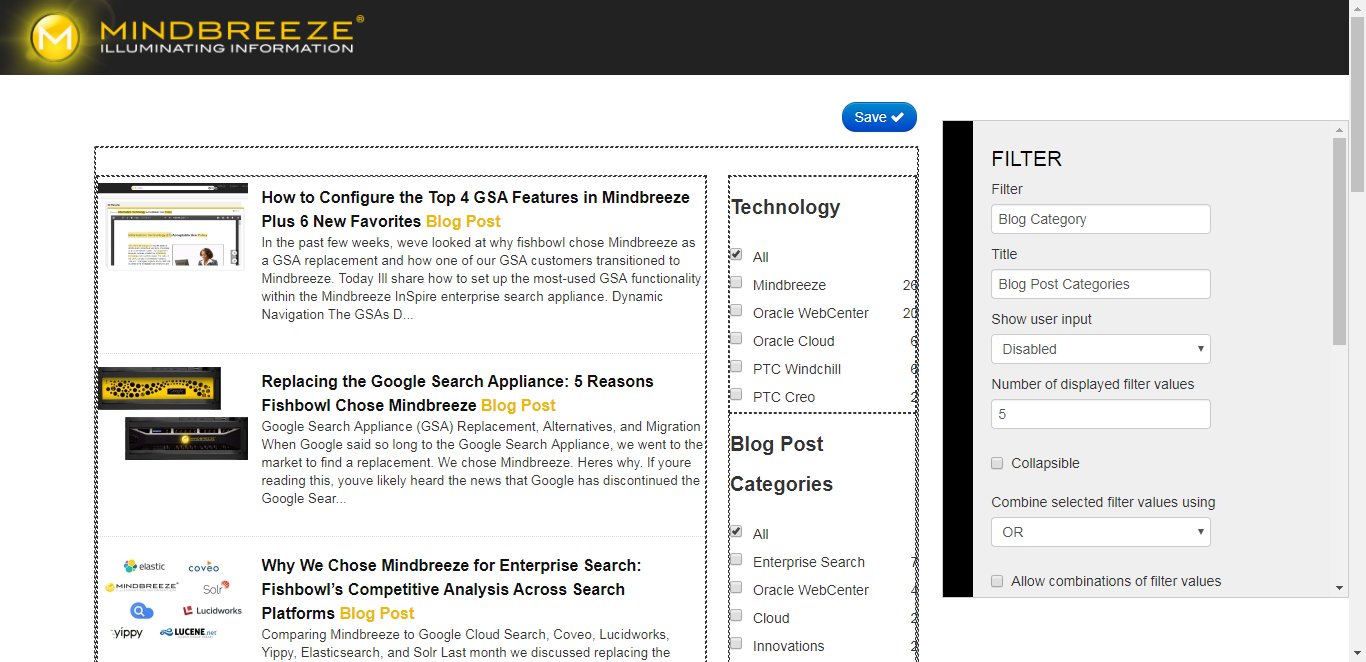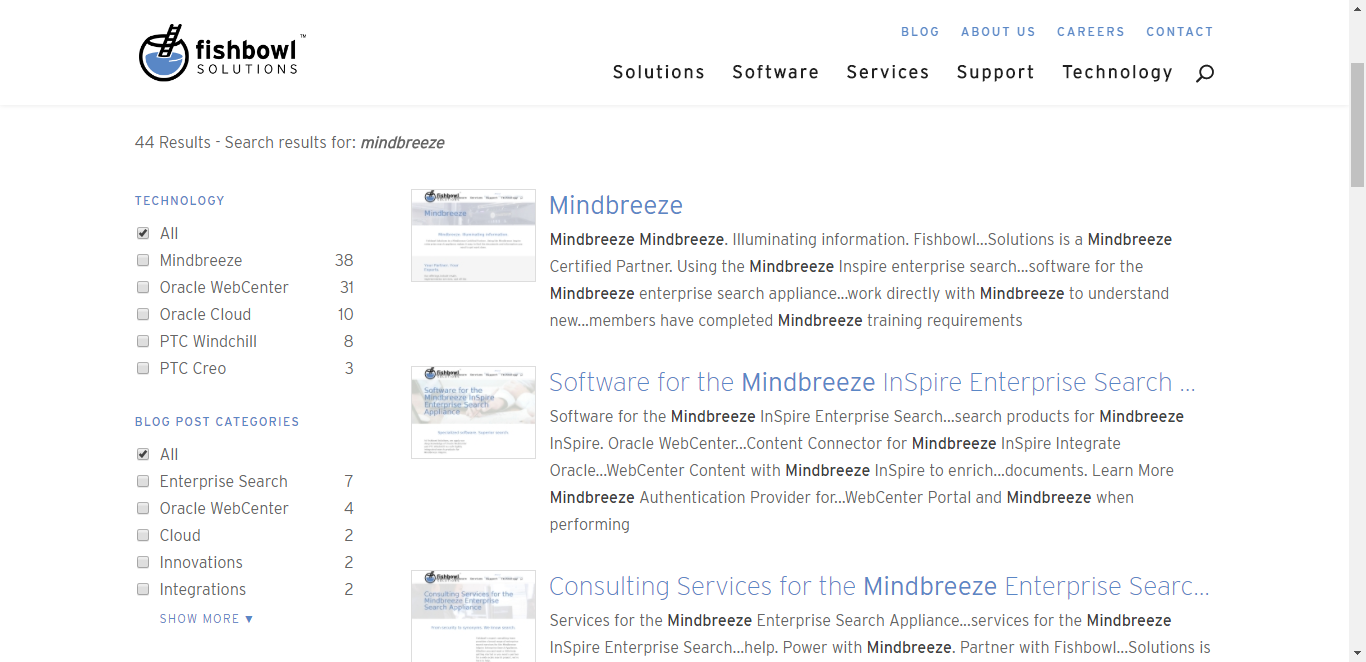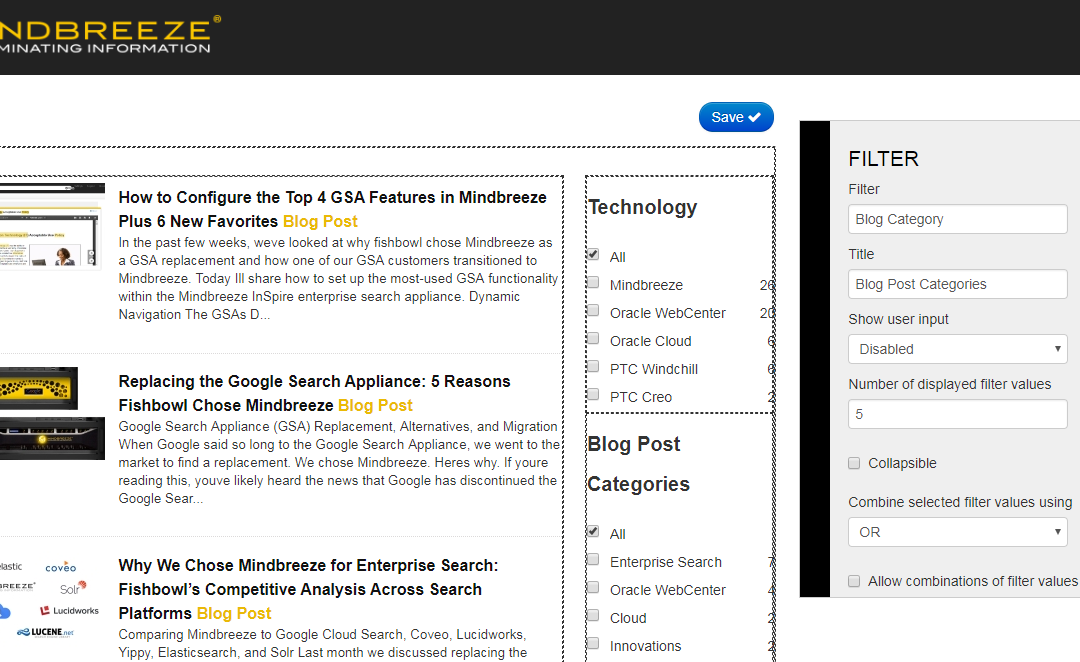A well-designed search interface is a critical component of an engaging search experience. Mindbreeze provides a nice combination of both pre-built search apps and tools for customization. This post explores the following approaches to building Mindbreeze search interfaces:
- The Mindbreeze Default Search Client
- The Mindbreeze Search App Designer
- Custom Mindbreeze Web Applications
- The Mindbreeze REST API
Option 1: The Mindbreeze Default Search Client
Flexibility: Low | Development Effort: None
Mindbreeze includes a built-in search client which offers a feature-rich, mobile friendly, search interface out of the box. Built-in controls exist to configure filter facets, define suggestion sources, and enable or disable export. Features are enabled and disabled via the Client Service configuration interface within the Mindbreeze Management Center. The metadata displayed within the default client is determined by the value of the “visible” property set in the Category Descriptor for the respective data sources. Some of the Mindbreeze features exposed through the default client are not available via a designer-built search app (discussed in Option 2). These include saved searches, result groupings (i.e. summarize-by), the sort-by picker, sources filters, and tabs. Organizations that wish to use these features without much effort would be wise to consider the Mindbreeze Default Search Client.

What is a Category Descriptor?
Mindbreeze uses an XML file called the Category Descriptor (categorydescriptor.xml) to control various aspects of both indexing and serving for each data source category (e.g. Web, SharePoint, Google Drive, etc.). Each category plugin includes a default Category Descriptor which can be extended or modified to meet your needs. Common modifications include adding localized display labels for metadata field names, boosting the overall impact of a metadata field on relevancy, and changing which fields are visible within the default search client.Option 2: The Mindbreeze Search App Designer
Flexibility: Moderate | Development Effort: None to Moderate
The Mindbreeze Search App Designer provides a drag-and-drop interface for creating modular, mobile-friendly, search applications. Some of the most popular modules include filters, maps, charts, and galleries. Many of these features are not enabled on the aforementioned default Client, so a search app is the easiest way to use them. This drag-and-drop configuration allows for layout adjustments, widget selection, and basic configurations without coding or technical knowledge. To further customize search apps, users can modify the mustache templates that control the rendering of each search widget within the search app. Common modifications include conditionally adjusting visible metadata, removing actions, or adding custom callouts or icons for certain result types.

Option 3: Custom Mindbreeze Web Applications
Flexibility: High | Development Effort: Low to Moderate
The default client mentioned in Option 1 can also be copied to create a new custom version of a Mindbreeze Web Application. The most common alteration is to add a reference to a custom CSS file which modifies the look and feel of the search results without changing the underlying data or DOM structure. This modification is easy and low risk. It also very easy to isolate issues related to such a change, as you can always attempt to reproduce an issue using the default client without your custom CSS.
More substantial modifications to the applications index.html or JavaScript files can also be made to significantly customize and alter the behavior of the search experience. Examples include adding custom business logic to manipulate search constraints or applying dynamic boosting to alter relevancy at search time. Other Mindbreeze UI elements can also be added to customized web apps using Mindbreeze HTML building blocks; this includes many of the elements exposed through the search app Designer such as graphs, maps, and timelines. While these types of alterations require deeper technical knowledge than simply adding custom CSS, they are still often less effort than building a custom UI from scratch (as described in Option 4). These changes may require refactoring to be compatible with future versions or integrate new features over time, so this should be considered when implementing your results page.
Option 4: The Mindbreeze REST API
Flexibility: High | Development Effort: Moderate to High
For customers seeking a more customized integration, the Mindbreeze REST API allows search results to be returned as JSON, giving you full control over their presentation. Custom search pages also allow for dynamic alterations to the query, constraints, or other parameters based on custom business logic. Filters, spelling suggestions, preview URLs, and other Mindbreeze features are all available in the JSON response, but it is up to the front-end developers to determine which features to render on the page, how to arrange them, and what styling to use. This approach allows for the most control and tightest integration with the containing site, but it is also the most effort. That said, just because custom search pages generally require the greatest effort is not to say selecting this option always will result in a lengthy deployment. In fact, one of our clients used the Mindbreeze API to power their custom search page and went from racking to go-live in 37 days.
—
Mindbreeze offers an excellent combination of built-in features with tools for extending capabilities when necessary. If you have any questions about our experience with Mindbreeze or would like to know more about the different Mindbreeze Search Interfaces, please contact us.

